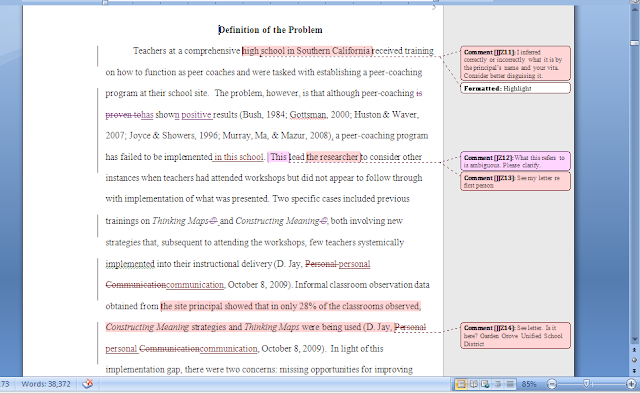Introduction to the Doctoral Form and Style: The Process and Outcomes
Monday, May 15, 2017
Capstone Writing
,
Dissertation
,
Revising
,
Writing Center Services
,
Writing Process
,
writing style
2 comments
Editing is one of the ways in which the Walden University Writing Center collaborates with students in their work during the Capstone process. The main function of the editors is to conduct the Form and Style Review, which occurs at the end of the dissertation or doctoral study process, after the initial committee approval and before the final oral presentation.
The goal for the Form and Style Edit can be described as two-fold. First, the editing process ensures that final manuscripts are APA compliant, and second, editors help students to polish the final product for ProQuest submission. Edits are also conducted with an additional emphasis on flow, cohesion, tone, voice, grammar, and American Academic English. The mission of the Walden Editors is to edit capstone manuscripts for ultimate ProQuest publication, in a supportive and nonjudgmental way, by applying their expertise in APA style, grammar, and the nuance of academic language. This is a collaborative and supportive process where editors help students to create the best, finished product possible.
Process
Once the student has completed writing the final study, meeting each of the document expectations, and the committee and URR have marked the document as met in MyDr, the document is passed to the Form and Style Editors. There are many considerations for the timing and process of the review, but basically, Editors have 14 days to conduct their review and will alert students and the committee, via e-mail, once they have begun working on the document. Again, editors focus on the main elements of APA Style as well as document formatting, grammar, and other aspects of scholarly writing and cohesion and flow. Editors generally mark three types of changes using the MS Word Track Changes Function:
- Required changes such as APA, grammar, writing, or formatting.
- Changes that are strongly recommended such as adding citations for information presented or revising language for clarity.
- Changes that would improve the overall quality of the published document such as moving discussions to other points in the document or revising headings.
Outcomes and the Finished Product
When the review is complete, the editor will return the document in MyDr and alert the student and committee that the review is accessible. In MyDr, Form and Style Editors will include a note detailing the documents attached and general instructions or tips for incorporating feedback and submitting a final, polished study to the committee.
Students will receive two documents via MyDr: a query letter and the marked document. In the query letter, the editor will explain the general types of changes that were made and where, describing the main APA Style or writing changes made during the review. This letter will also contain suggestions from the editor on areas where the student can focus attention during the revising process. The editor will also explain any other changes that should be made before the final document is submitted to the committee. The letter will also contain a tailored version of the Form and Style Checklist, highlighting areas for improvement links to resources that can help students in the process.
The second document students will find in MyDR is the marked document itself. Editors will use Track Changes to edit the document and provide explanations and comments in comment bubbles along the right-hand margin. Here is a sample screenshot of what a typical edit looks like after the Form and Style Review:
Once an editor has marked the document met in MyDr, the Form and Style Review is complete and the student/committee may move on to scheduling the Final Oral Presentation. Editors do not see the document again. The changes and comments are for the student and committee to review and incorporate as final revisions are made, keeping in mind the three types of changes that editors will be including. Editors are available for any questions about the review in general, or comments or changes made during the review. Check out the Walden University Form and Style Website for additional information and resources on editing at Walden and the Form and Style Review.
Kelly Chermack is the Manager of Editing Services in the Walden University Writing Center. She first joined the staff as a dissertation editor in 2012. She earned her PhD from the University of Minnesota in Sociology, and specializes in organization theory, workplace policy, and research methods. She is also a contributing faculty member in Walden's Human and Social Services PhD and Doctorate of Business Administration.
.png)
Never miss a new post; Opt-out at any time
Subscribe to:
Post Comments
(
Atom
)

.png)



Typo (cough cough)
ReplyDeleteThanks, Jeff! See: http://waldenwritingcenter.blogspot.com/2017/01/how-i-learned-that-editors-need-editors.html It happens to all of us :)
Delete